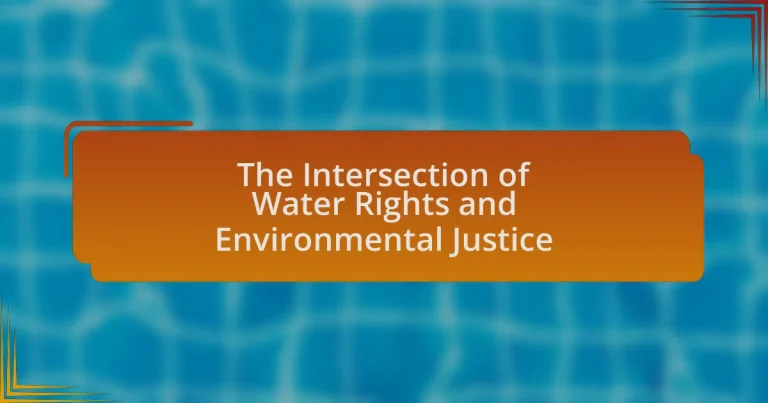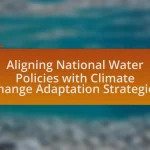The article examines the intersection of water rights and environmental justice, highlighting the legal entitlements governing water use and the equitable treatment of marginalized communities in environmental decision-making. It defines water rights, including riparian and prior appropriation systems, and discusses how these rights vary by region, particularly in relation to historical and socioeconomic contexts. The article emphasizes the disproportionate impacts of water pollution and scarcity on low-income and minority populations, illustrating the need for equitable policies that ensure access to clean water. Additionally, it explores the challenges faced by marginalized communities in securing water rights, the role of policy and economic factors, and the importance of community engagement and advocacy in promoting environmental justice.
What are Water Rights and Environmental Justice?
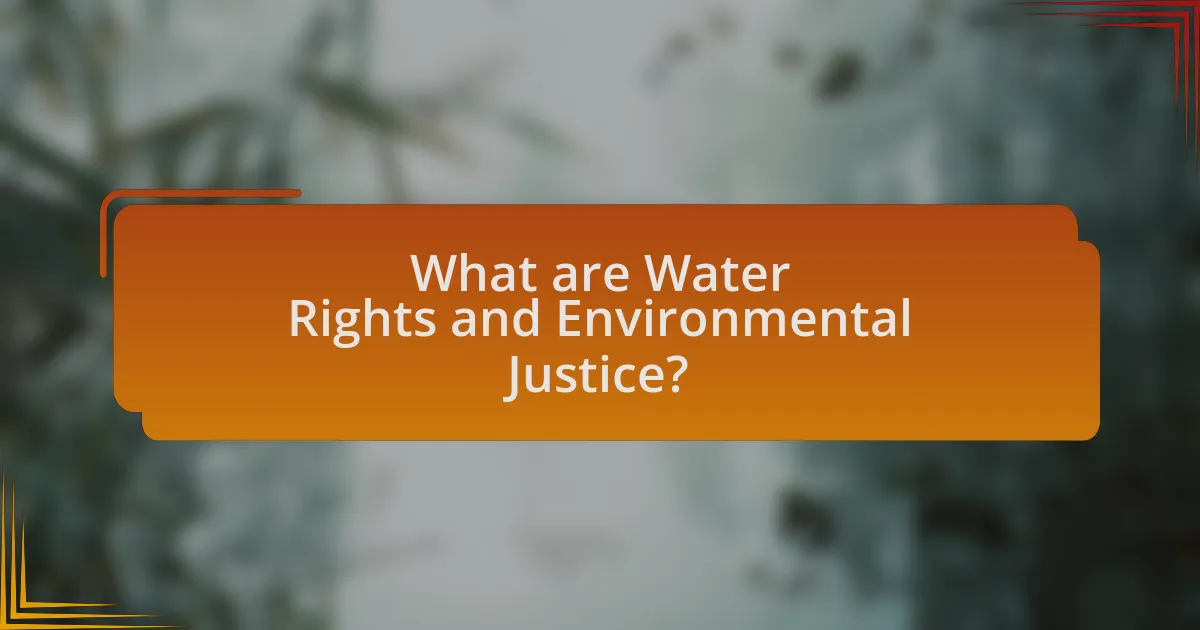
Water rights refer to the legal entitlements that govern the use and allocation of water resources, while environmental justice addresses the fair treatment and involvement of all people in environmental decision-making, particularly marginalized communities. Water rights are essential for ensuring access to clean water, which is a fundamental human right, and environmental justice seeks to rectify the disproportionate impacts of environmental hazards on disadvantaged populations. The connection between these two concepts is evident in cases where water scarcity or pollution disproportionately affects low-income or minority communities, highlighting the need for equitable policies that protect both water resources and vulnerable populations.
How are water rights defined in legal terms?
Water rights are legally defined as the entitlements that individuals or entities have to use water from a specific source, such as rivers, lakes, or groundwater. These rights can be categorized into two primary systems: riparian rights, which grant access to water based on land ownership adjacent to a water source, and prior appropriation rights, which allocate water based on a first-come, first-served principle, often used in arid regions. Legal frameworks governing water rights vary by jurisdiction, reflecting historical practices and local needs, and are often influenced by statutory laws, court decisions, and administrative regulations.
What are the different types of water rights?
The different types of water rights include riparian rights, prior appropriation rights, and groundwater rights. Riparian rights are associated with landowners whose property is adjacent to a water source, allowing them reasonable use of the water. Prior appropriation rights, often used in western U.S. states, allocate water based on a “first in time, first in right” principle, granting rights to those who first divert water for beneficial use. Groundwater rights pertain to the extraction and use of water from underground aquifers, which can vary significantly by jurisdiction, often governed by the rule of capture or correlative rights. These classifications are essential for understanding legal frameworks surrounding water access and usage, particularly in the context of environmental justice.
How do water rights vary by region?
Water rights vary significantly by region due to differing legal frameworks, historical contexts, and environmental conditions. In the western United States, for example, the doctrine of prior appropriation governs water rights, where rights are allocated based on the first user principle, prioritizing those who have historically used the water. In contrast, eastern states typically follow the riparian rights system, where landowners adjacent to a water source have the right to use it, reflecting a more communal approach. Additionally, regions facing water scarcity, such as parts of the Middle East and North Africa, often have stricter regulations and conflicts over water access, influenced by geopolitical factors. These variations highlight the complex interplay between local laws, historical usage, and environmental challenges in determining water rights.
What is the concept of environmental justice?
Environmental justice is the principle that all individuals, regardless of race, ethnicity, or socioeconomic status, have the right to a healthy environment and equitable access to natural resources. This concept emphasizes the fair distribution of environmental benefits and burdens, addressing the disproportionate impact of environmental hazards on marginalized communities. For instance, studies have shown that low-income and minority populations are more likely to be located near hazardous waste sites, leading to higher exposure to pollutants and associated health risks. This inequity highlights the need for policies that ensure environmental protection and resource access for all communities, thereby reinforcing the validity of the environmental justice framework.
How does environmental justice relate to marginalized communities?
Environmental justice is fundamentally connected to marginalized communities as it addresses the disproportionate environmental burdens they face, such as pollution and lack of access to clean water. Marginalized communities often reside in areas with higher exposure to environmental hazards due to systemic inequalities, including socioeconomic status and racial discrimination. For instance, studies have shown that communities of color are more likely to be located near hazardous waste sites, which contributes to health disparities. This relationship highlights the need for equitable policies that ensure all communities have the right to a healthy environment, thereby promoting social justice alongside environmental protection.
What are the key principles of environmental justice?
The key principles of environmental justice include the fair distribution of environmental benefits and burdens, the right of all individuals to participate in environmental decision-making, and the recognition of the historical and systemic inequalities faced by marginalized communities. These principles emphasize that no group should bear a disproportionate share of negative environmental impacts, such as pollution or resource depletion, and that all communities should have equal access to clean air, water, and land. The United States Environmental Protection Agency (EPA) defines environmental justice as the fair treatment and meaningful involvement of all people, regardless of race, color, national origin, or income, in environmental laws, regulations, and policies.
Why is the intersection of water rights and environmental justice important?
The intersection of water rights and environmental justice is important because it addresses the equitable distribution and access to clean water, which is essential for health and well-being. Historically, marginalized communities often face disproportionate impacts from water pollution and scarcity, leading to health disparities and social inequities. For instance, the Flint water crisis highlighted how systemic neglect of low-income communities can result in severe public health crises, emphasizing the need for policies that ensure fair water access and protect vulnerable populations. This intersection is crucial for promoting social equity and safeguarding environmental health, as access to clean water is a fundamental human right recognized by the United Nations.
What historical events highlight this intersection?
Key historical events that highlight the intersection of water rights and environmental justice include the 1969 Santa Barbara oil spill, which raised awareness about environmental degradation and its impact on marginalized communities, and the 2014 Flint water crisis, where systemic neglect led to lead contamination in drinking water, disproportionately affecting low-income residents and communities of color. These events underscore the critical relationship between access to clean water and social equity, illustrating how environmental policies can either exacerbate or alleviate injustices faced by vulnerable populations.
How do water rights impact environmental justice movements?
Water rights significantly impact environmental justice movements by determining access to clean and sufficient water resources, which are essential for marginalized communities. These communities often face disproportionate challenges in securing water rights, leading to inequities in health, economic stability, and environmental quality. For instance, in the United States, Indigenous tribes have historically been denied equitable access to water resources, which has fueled movements advocating for recognition and restoration of their water rights. Research indicates that areas with contested water rights often experience higher rates of pollution and resource depletion, exacerbating social injustices. Thus, the struggle for water rights is intrinsically linked to broader environmental justice efforts, as equitable access to water is a fundamental aspect of achieving social equity and environmental sustainability.
What are the Challenges at the Intersection of Water Rights and Environmental Justice?
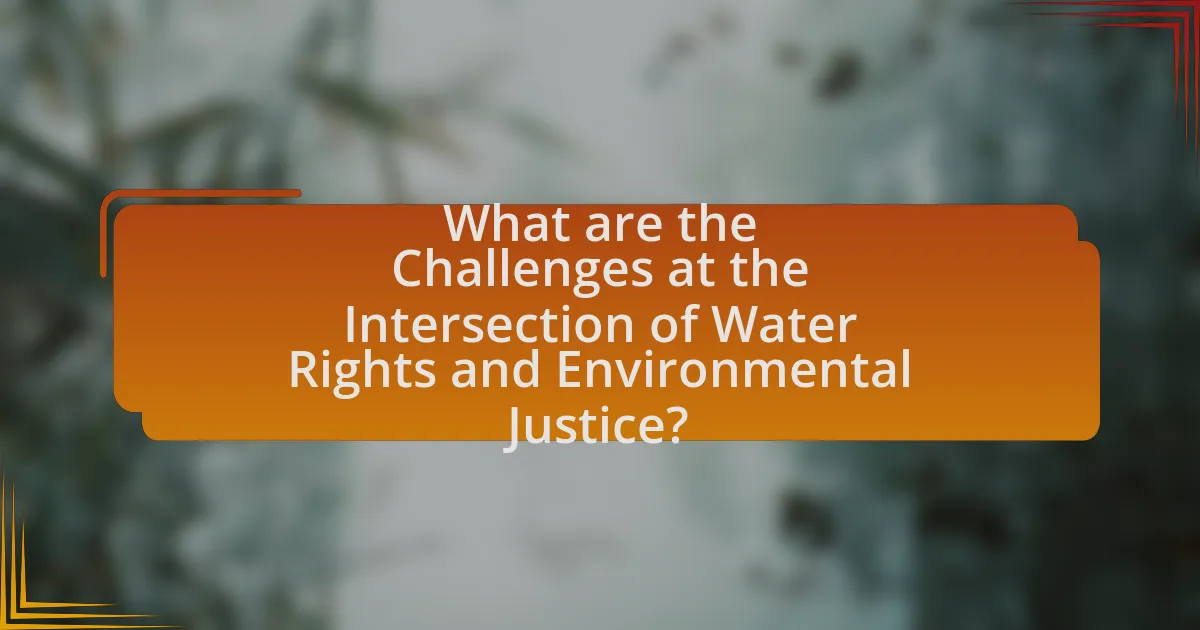
The challenges at the intersection of water rights and environmental justice include unequal access to clean water, regulatory disparities, and the impact of pollution on marginalized communities. Marginalized groups often face systemic barriers that limit their access to water resources, leading to health disparities and economic disadvantages. For example, in the United States, communities of color are disproportionately affected by water contamination, as seen in Flint, Michigan, where lead poisoning primarily impacted African American residents. Additionally, regulatory frameworks often prioritize industrial interests over the rights of local communities, exacerbating environmental injustices. These challenges highlight the need for equitable policies that ensure all communities have access to safe and clean water.
What barriers exist for marginalized communities in accessing water rights?
Marginalized communities face several barriers in accessing water rights, including legal, economic, and social obstacles. Legal barriers often manifest as inadequate representation in policy-making processes, leading to laws that do not prioritize their needs. Economic barriers include the inability to afford water infrastructure or the costs associated with legal claims for water rights. Social barriers involve discrimination and lack of awareness about water rights, which can prevent these communities from advocating for themselves. For instance, a report by the United Nations highlights that indigenous populations frequently encounter systemic discrimination that limits their access to water resources, illustrating the intersection of social injustice and environmental rights.
How do economic factors influence water access?
Economic factors significantly influence water access by determining the affordability and availability of water resources. In regions where economic conditions are poor, individuals and communities often face higher costs for water services, leading to limited access. For instance, according to the World Bank, approximately 1.2 billion people live in areas where water is scarce, and economic constraints prevent them from investing in necessary infrastructure or purchasing water at market rates. Additionally, wealthier areas tend to have better infrastructure and more reliable water supply systems, exacerbating inequalities in access. This disparity highlights how economic status directly correlates with the ability to secure adequate water resources, impacting overall health and quality of life.
What role does policy play in creating barriers?
Policy plays a significant role in creating barriers by establishing regulations and frameworks that can restrict access to resources, such as water rights. For instance, policies that prioritize industrial water use over community needs can marginalize vulnerable populations, limiting their access to clean water. Research indicates that in many regions, such as California, water allocation policies disproportionately favor agricultural and urban interests, often at the expense of low-income communities and indigenous groups. This inequitable distribution exemplifies how policy decisions can institutionalize barriers, perpetuating environmental injustice and exacerbating social inequalities.
How does pollution affect water rights and environmental justice?
Pollution significantly undermines water rights and exacerbates environmental injustice by disproportionately affecting marginalized communities. These communities often rely on contaminated water sources for drinking and agriculture, leading to health disparities and economic challenges. For instance, the Flint water crisis highlighted how systemic neglect and pollution can violate the water rights of residents, particularly impacting low-income and predominantly Black neighborhoods. Studies show that communities of color are more likely to be situated near polluted water sources, which reinforces existing inequalities and limits access to clean water. This intersection of pollution, water rights, and environmental justice illustrates the urgent need for equitable policies that protect vulnerable populations from environmental harm.
What are the sources of water pollution affecting communities?
The sources of water pollution affecting communities include industrial discharges, agricultural runoff, sewage and wastewater, and stormwater runoff. Industrial discharges introduce heavy metals and toxic chemicals into water bodies, while agricultural runoff carries fertilizers and pesticides that contaminate local water sources. Sewage and wastewater from households and industries can lead to the presence of pathogens and nutrients in water, causing health risks. Stormwater runoff collects pollutants from urban surfaces, further degrading water quality. According to the U.S. Environmental Protection Agency, nonpoint source pollution, primarily from agricultural and urban areas, is a leading cause of water quality impairment in rivers and lakes.
How do environmental regulations impact water quality for vulnerable populations?
Environmental regulations significantly improve water quality for vulnerable populations by establishing standards that limit pollutants and protect water sources. These regulations, such as the Clean Water Act in the United States, mandate regular monitoring and enforcement of water quality standards, which directly benefits communities that may lack resources to advocate for clean water. Studies have shown that areas with stringent environmental regulations experience lower levels of contaminants, leading to better health outcomes for populations at risk, including low-income and minority communities. For instance, research published in the journal Environmental Health Perspectives indicates that stricter regulations correlate with reduced incidences of waterborne diseases in these vulnerable groups.
What Solutions Exist to Address Water Rights and Environmental Justice Issues?
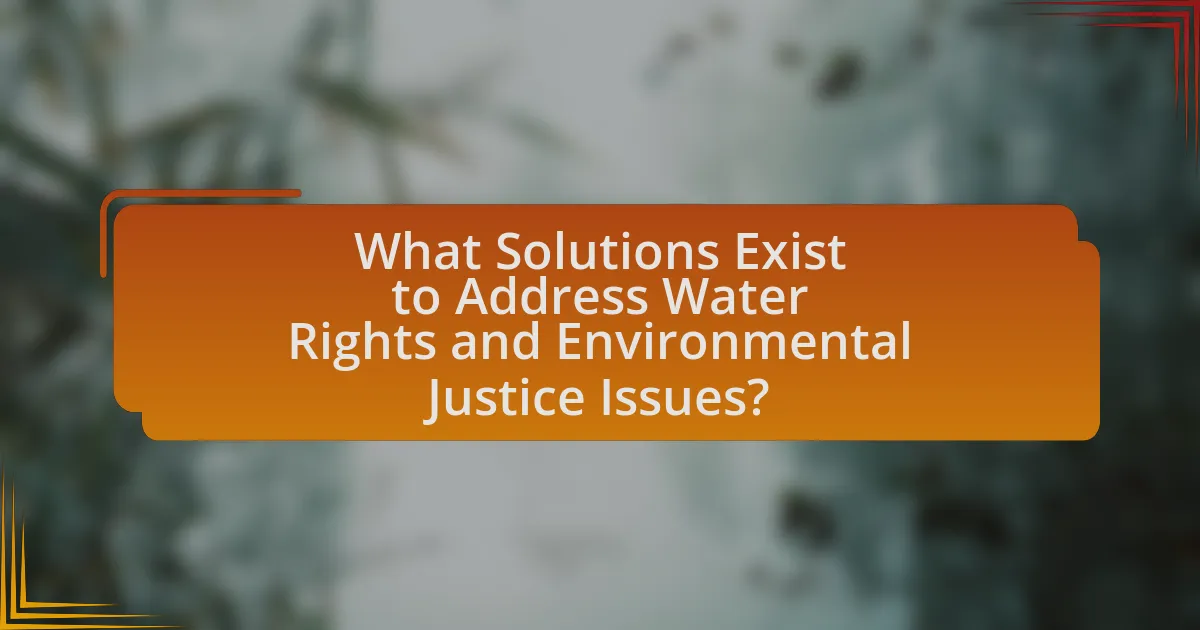
Solutions to address water rights and environmental justice issues include policy reforms, community engagement, and legal frameworks that prioritize equitable access to water resources. For instance, the establishment of water rights adjudication processes can help clarify and secure water rights for marginalized communities, ensuring they have legal recognition and access to necessary resources. Additionally, implementing participatory governance models allows affected communities to have a voice in decision-making processes regarding water management, which can lead to more equitable outcomes. Evidence from the United Nations highlights that inclusive water governance can significantly improve access for disadvantaged groups, thereby promoting social equity and environmental justice.
How can policy reforms improve water rights for marginalized communities?
Policy reforms can improve water rights for marginalized communities by establishing equitable access to water resources and ensuring legal protections against discrimination. These reforms can include the recognition of traditional water rights, the implementation of inclusive decision-making processes, and the allocation of resources to support infrastructure development in underserved areas. For instance, the United Nations recognizes the human right to water and sanitation, emphasizing that states must prioritize marginalized groups in their policies. Additionally, studies have shown that inclusive water governance can lead to better resource management and improved community health outcomes, demonstrating the effectiveness of such reforms in addressing historical inequities.
What successful case studies demonstrate effective policy changes?
Successful case studies demonstrating effective policy changes in the intersection of water rights and environmental justice include the 2012 California Sustainable Groundwater Management Act and the 2014 Water Quality Control Plan for the San Francisco Bay-Delta. The California Sustainable Groundwater Management Act established a framework for sustainable groundwater management, empowering local agencies to develop plans that address over-extraction and promote equitable water distribution. This policy change was driven by the need to protect water resources for disadvantaged communities, ensuring their access to clean water.
The 2014 Water Quality Control Plan aimed to improve water quality and ecosystem health in the San Francisco Bay-Delta, addressing the needs of both human populations and wildlife. This plan incorporated stakeholder input, including voices from marginalized communities, which led to more equitable water management practices. Both case studies illustrate how effective policy changes can enhance water rights while promoting environmental justice, supported by legislative frameworks that prioritize sustainability and community engagement.
How can community engagement influence policy reform?
Community engagement can significantly influence policy reform by ensuring that the voices and needs of affected populations are heard and considered in decision-making processes. When communities actively participate in discussions about water rights and environmental justice, they can provide valuable insights and data that highlight local issues, such as contamination or access disparities. For instance, the Flint water crisis demonstrated how community advocacy led to increased scrutiny and eventual policy changes regarding water safety regulations. Engaging communities fosters transparency and accountability, which are essential for effective policy reform.
What role do non-profit organizations play in advocating for water rights?
Non-profit organizations play a crucial role in advocating for water rights by raising awareness, mobilizing communities, and influencing policy changes. These organizations often conduct research to highlight water access disparities and engage in grassroots campaigns to empower affected populations. For instance, organizations like the Waterkeeper Alliance work to protect water resources through legal action and public education, demonstrating the effectiveness of advocacy in achieving tangible outcomes. Their efforts contribute to shaping legislation and ensuring that marginalized communities have a voice in water management decisions, thereby promoting environmental justice.
How do these organizations support affected communities?
Organizations support affected communities by advocating for equitable access to water resources and addressing environmental injustices. They engage in policy advocacy to influence legislation that protects water rights, ensuring marginalized communities have a voice in decision-making processes. For instance, organizations like the Waterkeeper Alliance work to monitor water quality and hold polluters accountable, which directly benefits communities facing contamination issues. Additionally, these organizations provide educational resources and legal assistance, empowering communities to understand their rights and take action against violations. This multifaceted approach not only addresses immediate water-related concerns but also fosters long-term resilience and sustainability within affected communities.
What strategies do they employ to raise awareness?
They employ community engagement and education initiatives to raise awareness about water rights and environmental justice. These strategies include organizing workshops, public forums, and outreach programs that inform communities about their rights and the importance of equitable water access. For instance, organizations often collaborate with local leaders to disseminate information through culturally relevant materials, ensuring that marginalized communities understand the legal frameworks surrounding water rights. This approach is supported by studies showing that informed communities are more likely to advocate for their rights and participate in decision-making processes related to water management.
What practical steps can individuals take to support water rights and environmental justice?
Individuals can support water rights and environmental justice by advocating for policies that protect water resources and participating in community initiatives focused on equitable access to clean water. Engaging in local governance, such as attending town hall meetings or joining environmental advocacy groups, allows individuals to voice concerns and influence decision-making processes regarding water management.
Additionally, individuals can educate themselves and others about the importance of water rights, particularly in marginalized communities, where access to clean water is often compromised. Supporting organizations that work on water justice issues, such as the Waterkeeper Alliance or the Indigenous Environmental Network, can amplify efforts to address systemic inequalities in water access.
Moreover, practicing sustainable water use at home, such as reducing water waste and advocating for water conservation measures, contributes to the broader goal of environmental justice. By taking these steps, individuals can play a crucial role in promoting equitable water rights and fostering a more just environmental landscape.
